3 April, 2000
Palmer Station; Norm LaVoie, Maintenance Technician
Question 44: Are icebergs made of salt water or fresh water?
Windy weather with snow and sleet continues today; we are not diving. The
L.M. Gould arrived for the final time (before our departure) yesterday
morning. It brought the last of the winter crew and the team working with the
station's hazardous waste materials. Every two years the hazmat generated by
science groups is sorted, documented, and shipped back to Chile or the United
States (depending on what it is) to be disposed of properly. The Gould is
leaving today and will take two weeks to return to Chile by way of a science
cruise in the Weddell Sea to the east of the Antarctic Peninsula. After
departure there will be 34 people on station.
Yesterday, in addition to a tour of the station's water system, our
Maintenance Technician, Norm LaVoie, showed me through some of the station's
other basic operating systems.
The station generates its own electrical power with two main generators (250
kilowatts each) that are housed on the first floor of GWR. There is a smaller
auxiliary (back-up) generator in BioLab that generates 100 kw and is run once
a week. Everything on the station except the Zodiacs, four-wheeler and
snowmobiles operates on diesel fuel. The approximately 100,000 gallons used
each year by the station are off loaded by the Gould in two batches. 70,000
gallons were just off loaded in February. For comparison, one tanker truck
holds 10,000 gallons. With all the pumps on the ship and the station working,
it took seven hours to transfer the fuel from ship to station.
While the fuel is being transferred, a containment boom is placed around the
Gould to prevent any accidental spillage from contaminating the marine
environment. Like all other vital systems at Palmer, the fuel storage system
has a back up. There is fuel in only one of the two tanks. The second is
strictly to transfer the fuel to in case of a leak in the primary storage
tank. There is always diesel fuel in the line. Gravity feeds the "gas
station" by the boathouse, which is used to fill up all the heavy equipment.
BioLab and GWR each have a day tank that holds the diesel for use in heating
and running generators on a daily basis.
The non-hazardous, biological waste generated by the station goes through a
macerator (like a large garbage disposal unit) and is diluted by sea water
before it is flushed out into Hero Inlet. Our regular trash is collected,
sorted, compacted and sent back to Chile for disposal in the Punta Arenas
landfill. The science waste that is not toxic also goes to Chile. However,
anything that looks like it came from a laboratory, even if it isn't
dangerous, goes back to the United States.
Finally, to prevent us from starving, outside the end of the BioLab building
are two freezer vans that contain enough food to feed the station for an
entire year. The food is constantly rotated so that it doesn't spoil and
includes things like turkey rather than only canned meat.
Norm leaves today on the Gould, but has been here for the entire summer
season starting in October. This is his first and probably only trip to the
ice. It is an experience he looks upon as a once-in-a-lifetime opportunity
involving many firsts for him: a ship voyage across the Drake Passage; travel
to Spanish-speaking countries south of the equator; and living in Antarctica
for seven months. The hard part has been spending so much time away from his
family, something he is not willing to do again.
Norm has worked for a variety of companies in the Boston area operating and
working on building and hospital maintenance systems. He has an Unlimited
Refrigeration Technician, a Boiler Technician, and a Federal Reclaimers (for
CFC and freon, hazmat) license. Norm says he would have been astounded two
years ago if someone had told him that he would come to Antarctica, but he
was looking for a change of pace and when the idea of working in Antarctica
came up it rang all the bells as something he wanted to do.
In his job, he maintains all the basic systems that allow the station to run,
does general repairs and gives station tours to the summer visitors from ships
that visit. He has enjoyed his time here immensely. He is an avid rock hound
(the area's rocks contain quartz, granite, basalt and iron pyrite) and
geography buff--now he has been to a continent that only 3,500 researchers and
10,000 tourists a year out of 6 billion people get to visit. Norm feels very
lucky to have come to the Peninsula. He views Palmer as the Grand Central
Station of Antarctica. Everything, including wildlife, icebergs, fantastic
scenery, ships, and planes (two British Twin Otters landed on the glacier
behind the station on their way from Rothera to Chile for the winter) can be
found here!
Answer 43: The Kelvin scale is the other universal temperature scale. Its
degrees are measured in the same increments as the Centigrade scale but starts
at absolute zero (equal to -273.16 degrees C). There is a special
low-temperature scale called the Leyden scale. It uses the boiling points of
hydrogen (-253 C) and oxygen (-183 C) as its fixed points and divides the
interval using the Centigrade degree. The Reaumur scale, freezing point of
water at 0 and boiling at 80 degrees, is still used in some areas of Europe.
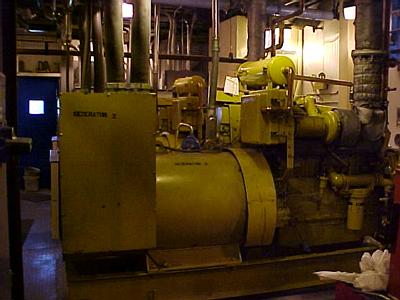
The station's main generators.

Diesel intake line hookup at boathouse.

Macerator grinders on our waste line.
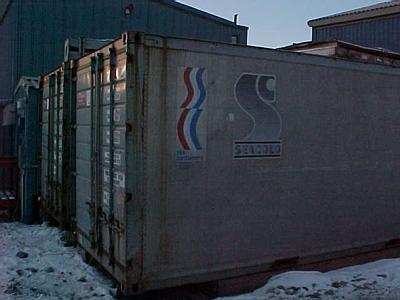
Food storage vans.
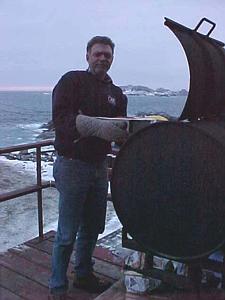
Norm is also responsible for our Sunday barbecued beans!
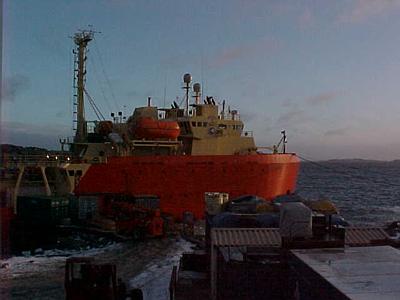
The R.V. Laurence M. Gould leaving Palmer Station.
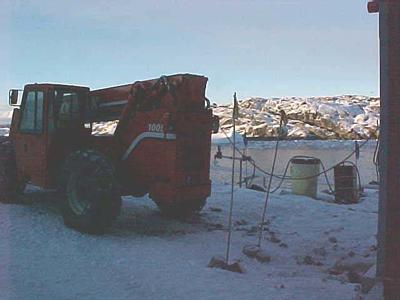
Palmer "gas station" on the fuel line.

Contact the TEA in the field at
.
If you cannot connect through your browser, copy the
TEA's e-mail address in the "To:" line of
your favorite e-mail package.
|
